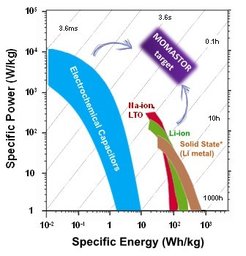Design and Analysis of Na-ion Energy Storage Device

The development of electrochemical devices that can efficiently store and release energy while also possessing high energy and power densities is crucial to overcome the current unsustainable exploitation of fossil fuels. Lithium-ion batteries, which store charges by redox reactions are the current standard for high energy density performance, beside great achievements during the last 30 years, are still rather expensive as they are based on raw and non-sustainable materials (such as Li and Co), and present low cycle stability. In this regard, our aim is to target a more sustainable solution to our broad energy-storage needs based on sodium-ion batteries.

In 2018, the EU only covered 42% of its energy needs. The energy produced can be divided into five different sources: Petroleum products (including crude oil) (36 %), natural gas (21 %), solid fossil fuels (15 %), renewable energy (15 %) and nuclear energy (13 %). The production of energy is, however, just the first step. With the aim of a total decarbonization of the energy sector by 2050, one of the primary goals of the Europe Member states is to explore deployment potentials and actual needs for energy storage, along with increasing the production from renewable sources. The careful design of the batteries, in terms of electrodes, electrolytes, and SEI layers is therefore of paramount importance.
With that in mind, the careful design of the electrode materials, electrolytes and synthetic SEI layers that are carefully analyzed by a combination of spectroscopic, microscopic and electrochemical characterization. In this way, we aim to design Na-ion batteries with high power and energy density for a new and more sustainable energy storage.
Credit: Icons vector created by vectorpocket - www.freepik.com

